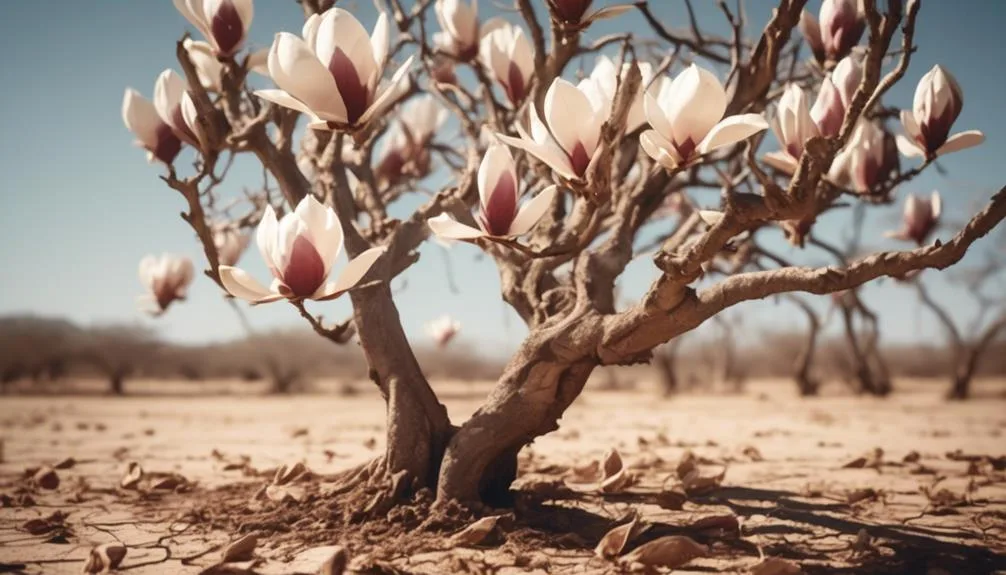Magnolia trees are known for their stunning beauty, but can they survive drought? Their ability to withstand dry conditions is a fascinating topic for those interested in cultivating these iconic trees.
Let's explore how magnolia trees cope with drought, a crucial aspect for their caretakers. Understanding their resilience in arid environments is essential.
So, can these majestic trees endure drought and still bloom? It's an intriguing question worth examining.
Drought Tolerance of Magnolia Trees
To thrive in dry conditions, magnolia trees have developed impressive drought tolerance, enabling them to survive with minimal water. Their adaptability to different soil conditions and climates is remarkable.
Magnolia trees can thrive in well-drained, slightly acidic soils, but they're also known to tolerate a range of soil types. Their ability to adapt to various climates, including both humid and arid regions, makes them highly versatile.
They've evolved to withstand periods of drought by developing deep root systems that can access water sources other plants can't reach. Additionally, their waxy leaves help minimize water loss through transpiration, allowing them to conserve moisture during dry spells.
This exceptional climate adaptation and resilience make magnolia trees a valuable addition to gardens and landscapes in regions prone to drought.
Magnolia Tree Watering Needs
The impressive drought tolerance of magnolia trees directly influences their specific watering needs, which is essential to understand for their proper care and maintenance. Magnolia trees generally require regular watering, especially during their initial establishment period. Adequate watering frequency is crucial to ensure the soil moisture remains consistent.
During dry periods, it's important to water deeply, allowing the moisture to penetrate the root zone. However, it's equally important to avoid overwatering, as this can lead to root rot and other issues. A good practice is to monitor the soil moisture levels by checking the top few inches of soil and adjusting the watering frequency accordingly.
Generally, magnolia trees prefer well-draining soil that retains some moisture but doesn't become waterlogged.
Tips for Helping Magnolia Trees Thrive in Drought
Consider implementing mulch around your magnolia tree to help retain soil moisture and protect the roots during drought conditions. Mulch acts as a barrier, preventing water from evaporating too quickly from the soil. This helps maintain soil moisture levels, which is crucial for the health of your magnolia tree during drought.
When applying mulch, ensure it's spread uniformly around the base of the tree, extending out to the drip line. A 2-4 inch layer of organic mulch, such as wood chips or bark, is ideal. Additionally, consider using mulching techniques that incorporate compost or leaf litter, as these materials can further improve soil moisture retention.
Signs of Drought Stress in Magnolia Trees
Experiencing drought stress, magnolia trees may exhibit a range of symptoms that indicate their struggle to cope with limited water availability. One common sign is leaf wilting, where the leaves become droopy and lack their usual turgidity.
Another indicator of drought stress in magnolia trees is a decline in soil moisture. You may notice the soil around the base of the tree becoming dry and cracked.
Additionally, the leaves might start to turn brown or yellow at the edges, signaling their distress. Keep an eye out for these symptoms as they can help you identify when your magnolia tree is under drought stress and in need of water.
Monitoring soil moisture levels and promptly addressing any signs of wilting can help mitigate the effects of drought on your magnolia trees.
How to Revive a Drought-Affected Magnolia Tree
If your magnolia tree is showing signs of drought stress, it's important to take immediate action to help revive it and restore its health. Here are some steps you can take to revive a drought-affected magnolia tree:
| Step | Details |
|---|---|
| Tree trimming | Prune any dead or damaged branches to promote new growth and reduce stress on the tree. Trim back to healthy wood and remove any diseased parts. |
| Soil nutrients | Ensure the soil around the tree is well-nourished. Add organic matter like compost and mulch to improve water retention and provide essential nutrients. Consider using a slow-release fertilizer specifically formulated for trees to replenish depleted nutrients. |
Conclusion
With proper care and attention, magnolia trees can thrive in drought conditions. Understanding their watering needs, providing extra hydration during dry spells, and recognizing signs of drought stress are key to their survival.
By nurturing your magnolia tree, it can continue to beautify your landscape for years to come, even in challenging conditions.

My interest in trees started when I first saw the giant sequoias in Yosemite.
I was a teenager then, and I remember thinking, “I need to learn more about this.”
That moment stuck with me.
A few years later, I went on to study forestry at Michigan Tech.
Since graduating, I’ve worked in a mix of hands-on tree care and community education.
I’ve spent over ten years helping people understand how to plant, maintain, and protect the trees in their neighborhoods.
I don’t see trees as just part of the landscape.
They are living things that make a real difference in our daily lives.
